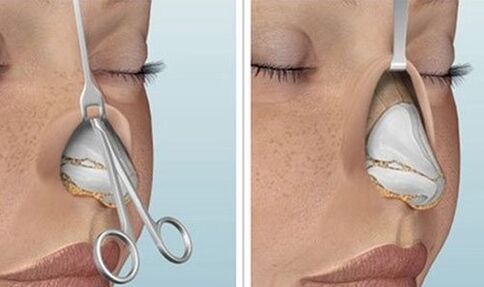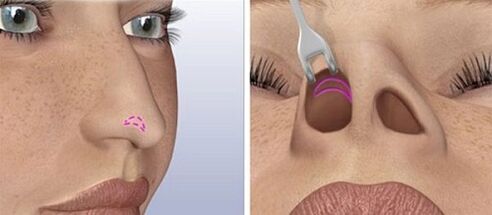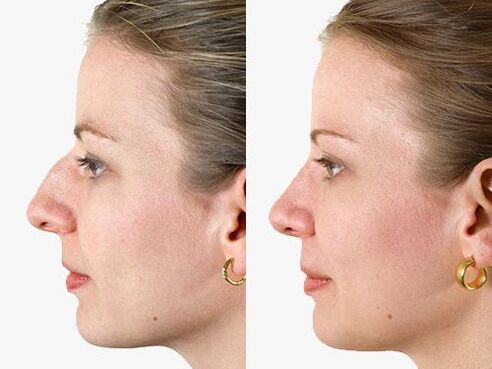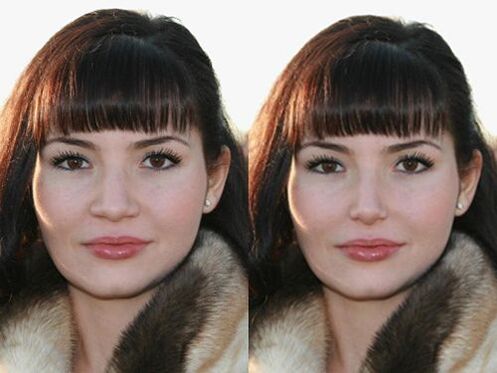
What is rhinoplasty or nose surgery?
This is one of the most common and oldest plastic surgery in the world (first performed in 1000 BC).
It represents the entire part of cosmetic surgery, which combines surgical correction of the shape and size of the nose, by replacing the congenital or acquired defects in this part of the face with osteochondral tissue taken from the patient.
Nose surgery changes the image of the patient and is considered to be one of the most effective ways to change the appearance.
Types and indications
The nose is an olfactory organ with a very complex anatomical structure. Surgical correction of this part of the body is considered to be one of the most difficult plastic surgery in the world, because doctors not only need to change its appearance, but also need to maintain its function (in some cases, this kind of surgery can cause bending of the osteochondral diaphragm, resulting inNasal breathing difficulties or loss of smell). Therefore, before performing a rhinoplasty, the surgeon recommends that the client carefully consider and answer the question whether it is worthwhile to do a rhinoplasty (except for cases where an irregularly shaped nose can cause breathing problems and cause hypoxia in the brain). The best age for command is20-30 years old, but if you have breathing problems or serious physical injuries, you should do it in advance.
Main indications:
- Compared with the entire face, the size of the respiratory organs is disproportionate;
- Turbinate hypertrophy;
- Injury or deformation of bone or cartilage tissue in the area of the osteochondral diaphragm, and its curvature;
- Asymmetry, bifurcation, or nose tip is too high;
- "hump";
- Lack of breathing or difficulty;
- Not satisfied with the results of previous plastics.
There are several types of rhinoplasty, which are classified according to the purpose and technique of the operation:
- Rhinoplasty-a method of surgically correcting the shape of the nose tip or eliminating asymmetry (bifurcation);
- Transplantation (autologous transplantation)-During the operation, the doctor will enlarge and extend the nose if necessary by transplanting cartilage tissue removed from the auricle area;
- Reduction-a surgical method aimed at correcting the shape and size of the turbinate;
- Back alignment-remove the hump at the back of the nose;
- Rhinoplasty-a surgical method to correct the deviation of the nasal septum;
- Rhinoplasty-a surgical method that corrects the shape of the bridge of the nose to eliminate the "flatness" effect;
- Non-surgical rhinoplasty-by injecting fillers (rhinoplasty), using hormone-absorbable drugs to destroy the osteochondral tissue in the nasal septum, or non-surgically correcting the shape, size and proportion of the nose with the help of the nasal septum. Aptos thread (Threaded lifting of wings and nose).
How is the preparation for the operation?
Before the operation, the patient needs to visit the plastic surgeon, he will measure the respiratory organs, determine the workload to be done, and use a special program to simulate the presumptive results of the operation on the computer (computer modeling helps the doctor to better understand the customerWillingness) and write recommendation letters for the following tests:
- General and clinical blood tests;
- ECG (with decoding);
- Fluoroscopy
- Analysis of AIDS, HIV or Hepatitis;
- Tomography of the paranasal sinuses.
Two weeks before the operation, you must stop smoking and stop taking blood-thinning drugs. Eating or drinking is not allowed 12 hours before the operation (light dinner is allowed the night before).
Before the operation, the doctor recommends a good rest and sleep (this will help calm the nervous system).
Technology depends on method
Before the operation, the client signs an agreement with the plastic surgery clinic, which contains his consent to the surgery, the cost and type of the surgery, the names of the anesthesiologist and plastic surgeon, and the patient's information to be familiar with the possibility of postoperative complications and their methods. treatment. After that, the patient is taken to the operating room, the face is cleaned with lotion, the perforation (if any) is removed, and if necessary, preoperative marking with special markers. The operation is performed under general intravenous or intratracheal anesthesia and lasts 1-2 hours.
There are two methods for rhinoplasty: open and closed.
Open rhinoplasty
Open rhinoplasty is an operation where the doctor makes an incision in the columella (the part of the skin between the nostrils) to correct the shape of the nose structure, and finally sew a few cosmetic stitches on the skin. This surgical intervention method is used to correct severe injuries and deformities of the nasal cavity, and to use autografts to reconstruct bone and cartilage tissue.

Closed rhinoplasty
Closed rhinoplasty is an operation in which the surgeon makes an incision in the nasal cavity, separates the soft tissue from the osteochondral framework, performs a series of surgical operations to change the shape of the nose, and then sutures the mucosa with self-absorbable sutures. material. A less traumatic plastic surgery method, there are few complications and scars afterwards.

In the case that the first operation is unsuccessful or the result is not suitable for the client, the doctor will perform a second (secondary) rhinoplasty. This is a more complicated (technically) operation that requires certain skills and practical experience of the surgeon. It is performed under general anesthesia and requires the same preparations as the main plastic. It was completed no earlier than one year after the previous surgical intervention.
Recovery period and results
The recovery period lasts 3-4 weeks, but the patient spends one day in the hospital. Immediately after the operation, a tampon was inserted into each nostril, the surgeon took it out three days later, and put a plaster model on the nose (taken out after ten days). After removing the tampon, the doctor will prescribe drops to the patient to eliminate postoperative edema and speed up the healing of soft tissues. The swelling and bruising disappeared completely after 1. 5-2 months. Preliminary results are evaluated after 6-8 months, and final results-12 months later. The scar after rhinoplasty is visible in the first three months and then almost invisible.
Postoperative recommendations:
- Two weeks after the surgical correction, you must sleep on your back;
- In the first few weeks, you cannot go to the sauna, swimming pool, solarium, gym and do heavy physical work;
- Until the wound is completely healed after surgery, you can only eat warm food and drink warm beverages;
- Do not wear glasses for 2-3 months after the operation;
- During the entire recovery period, you should not smoke.
Results of rhinoplasty or nose surgery: before and after photos


Possible complications and contraindications
Contraindications in progress:
- Oncology;
- Runny nose;
- Influenza, SARS;
- Active herpes;
- diabetes;
- Atrophic rhinitis;
- Oral infections;
- Insanity;
- tuberculosis;
- Diseases of the heart and kidneys.
Rhinoplasty surgery is known as one of the most difficult plastic surgery in the world. During this period, surgeons usually remove several cosmetic defects at the same time instead of one. Therefore, it is related to the development of many possible complications:
- Nosebleeds;
- Postoperative pigmentation;
- Soft tissue swelling and hematoma;
- Loss of smell;
- The appearance of keloid scars;
- Difficulty breathing;
- The nasal septum is curved.
What operations can be combined?
In most cases, rhinoplasty is combined with septoplasty-surgical correction of the nasal septum (this process is sometimes called septoplasty), lipplasty (change the shape and volume of the lips), and mammoplasty-aimed at correcting the nasal septumPlastic surgery breasts of shape and size (in the latter case, two doctors are present during the operation, one for rhinoplasty and the other for breast plastic surgery).
Estimated price of rhinoplasty (rhinoplasty)
Plastic surgeons provide accurate information about the cost of nose surgery. The cost of rhinoplasty includes initial consultation, hospitalization, computer simulation of results, removal of tampons and removal of bandages. The price of surgery depends on the type and method of surgical intervention.
Rhinoplasty is a surgery that is equally popular among women and men. It can help people get rid of health problems and improve the appearance and proportions of the face.




















